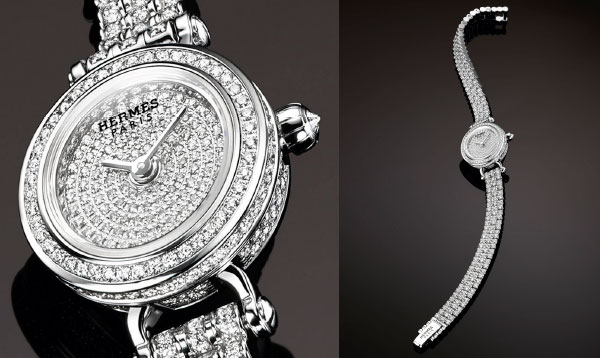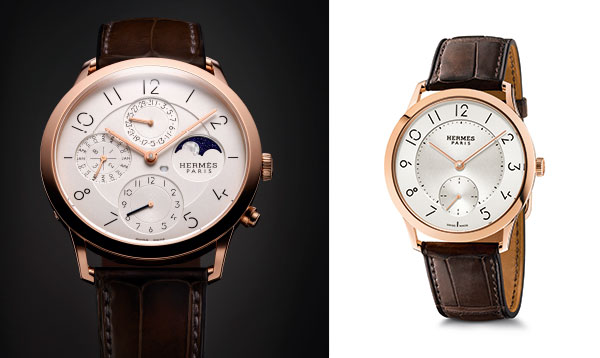
Dressage Petite Seconde
Case : rose gold, sapphire crystal Dimensions : 40,5 x 38,4 mm Movement : self-winding Caliber H1837, 28,800 vph, 50-hour power reserve Functions : hours, minute, small seconds Strap : alligator Water resistance : 50 mDressage Simple Calendar
Case : steel, sapphire crystal caseback Dimensions : 40,5 x 38,4 mm Movement : self-winding Caliber H1837, 28,800 vph, 50-hour power reserve
Functions : hours, minutes, seconds, date Strap : alligator Water resistance : 50 m
Arceau Petite Seconde
Case : rose gold, sapphire crystal caseback Diameter : 34 mm Movement: self-winding Caliber H1912 28,800 vph, 50-hour power reserve
Functions : hours, minutes, small seconds Strap : alligator Water resistance : 30 m
Arceau Petite Seconde
Case : steel, diamond-set bezel, sapphire crystal caseback Diameter : 34 mm Movement : self-winding Caliber H1912, 28,800 vph, 50-hour power reserve Functions : hours, minutes, small seconds Strap : alligator Water resistance : 30 m
Created in 2003 by Henri d’Origny, the Dressage watch is distinguished by its bevelled tonneau-shaped case and its integrated lugs extending a curve duly designed to mold the curve of the wrist. It is part of a longstanding tradition of aesthetic research inherent to the House of Hermès, which is accustomed to original lug designs ; and draws inspiration from certain 1930s models to express a certain form of contemporary sporting elegance. Today, just as at the time of its launch, the case comes in a size measuring 40.5 millimeters long by 38.4 millimetres wide, while the diameter of its round opening is 1.5 millimeters larger – a subtle way of emphasizing the distinctively horological nature of the new Dressage. In parallel, the dial is given added relief by a vertical stamping in the centre, sandblasted applied numerals and hour-markers, as well as openworked dauphine hands, while the crown is fitted even closer to the case. Ten models compose the 2012 collection equipped with the exclusive H1837 movement. There are eight steel versions, four displaying central seconds and the date, and four small seconds. They come with a choice of opaline, black or silver-toned models, and are fitted with steel bracelets or matt black or Havana alligator straps. The range is complemented by two pink gold models with small seconds, one featuring a silver-toned opaline dial and a matt Havana alligator strap, while the other with a matt graphite strap and dial is issued in a 175-piece limited edition in reference to the 175 years of the House of Hermès. Its oscillating weight is distinguished by a surface that is rhodiumed and gilded instead of satin-brushed.
The Manufacture Calibre H1912 is making its appearance inside an Arceau line reserved exclusively for women. The famous case with its stirrup-shaped asymmetrical lugs, designed by Henri d’Originy in 1978, adopts a diminutive 34-millimetre diameter. The distinctive sloping numerals are applied in relief on dials with a fan-shaped guilloché motif radiating from the small seconds display, while the crown is adorned with a charming rose-cut diamond. The cases of the standard collection come in steel with a bezel set with 60 diamonds, and in rose gold with a polished or gem-set bezel. They frame silver-toned dials and are fitted with matte blue, Havana or black alligator straps. A 100-piece limited edition celebrates the centenary of the date when the House of Hermès entered the watchmaking field. This jubilee model is crafted in rose gold and enlivened by 74 diamonds, lugs echoing the bezel, a natural mother-of-pearl dial surround and, like the Dressage anniversary model, by a rhodiumed and gilded oscillating weight
The centenary that Hermès is currently celebrating takes us back to 1912. The family business was known at the time as Hermès Frères (1902-1919) and was headed by Adolphe and Emile-Maurice, grandsons of the founder Thierry. From the 1920s onwards, Emile Maurice remained alone at the head of the company and it was he that was to lead it towards diversification, and in particular, towards watchmaking. The first watches bearing the Hermès signature were commercialized in 1928. Nonetheless, 1912, was a symbolic year immortalized by a photo of the four daughters of Emile-Maurice, and taken while the family was on holiday. The second, Jacqueline, is pictured wearing a pocket watch housed in a leather “porte-oignon” or dedicated holder crafted in the company workshops. This creation carries within it the genes of the forthcoming development. It is intimately bound up with the saddle-making universe and attached to the wrist in a clever manner that enabled it to be worn on horseback.
In 1928, the first watch to bear the Hermès name was a beautiful and ingenious leather-bound pocket watch, sheathed in leather and automatically rewound each time the wearer checked the time, via the opening system. Its movement was supplied by Movado, the first of the prestigious watch manufacturers with which Hermès was to collaborate for around fifty years, a list that also included Audemars Piguet, Baume & Mercier, Jaeger-LeCoultre, Ulysse Nardin, Universal Genève, Vacheron Constantin, etc.
1978 saw the establishment in Bienne, Switzerland, of the La Montre Hermès SA subsidiary. It was the point of departure for growing involvement in movement production, with the opening of assembly workshops and the affirmation of an authentic watchmaking vocation. The famous collections to emerge from the Bienne workshops bear names such as Arceau, Clipper, Sellier, Cape Cod, H-our, as well as Dressage which has generated a new wave of progress.
The Dressage watch was the first to incorporate a movement produced by the Manufacture Vaucher, three years before Hermès acquired a stake that is a considerable source of satisfaction to Luc Perramond, CEO of La Montre Hermès: “Thanks to the acquisition in 2006 of 25% of the Vaucher shares, we enjoy access to exclusive finely crafted movements. The base caliber of the H1837 and H1912 movements, which was entirely developed and industrialized by our respective teams, heralds an era brimming with greater than ever horological promise.




